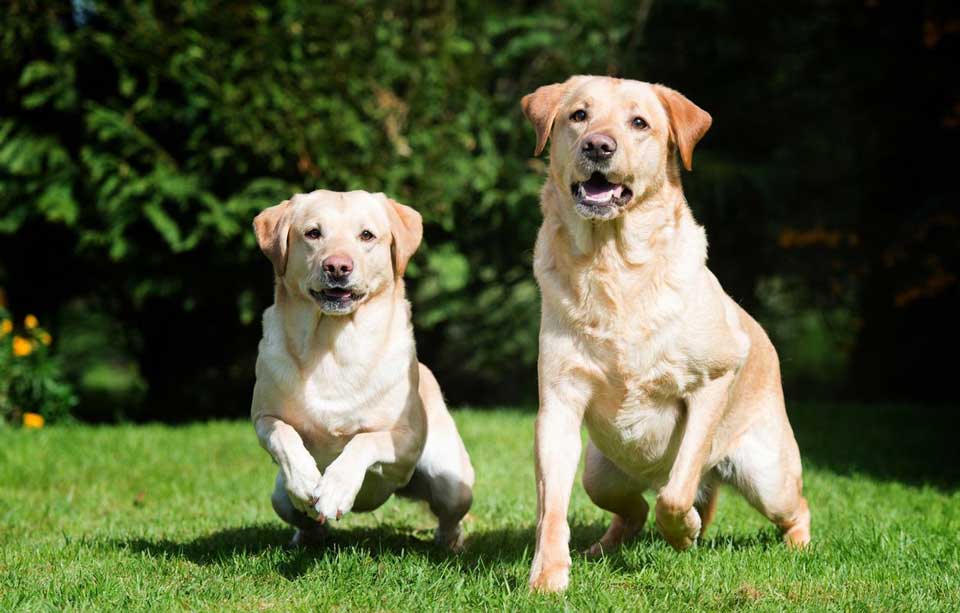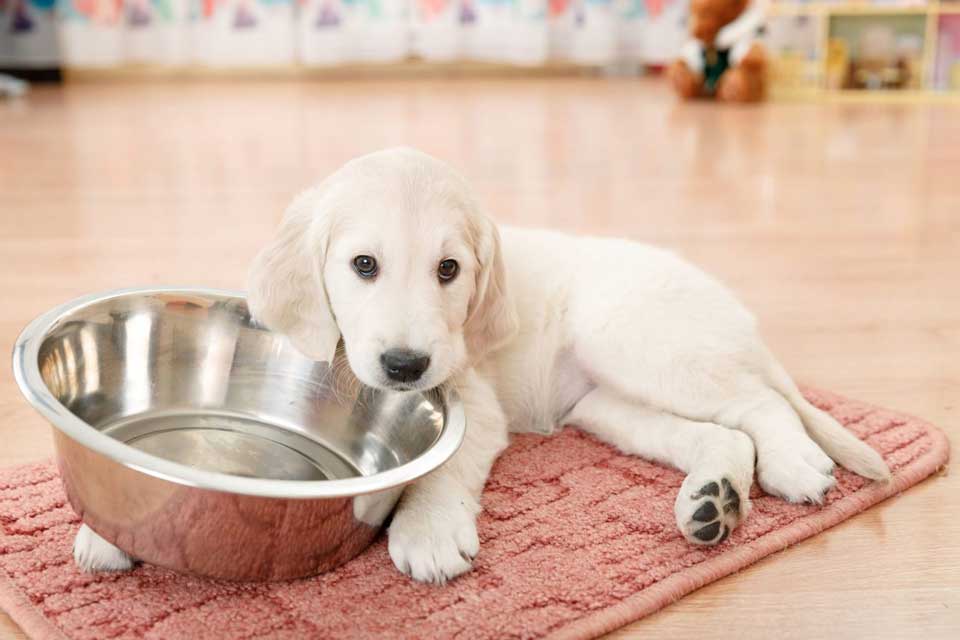Labrador Retrievers are very popular as pets in many countries. They are among the top ten smartest dogs and are easy to train. But the main advantage of the owners is their jovial and good-natured disposition. Labradors serve as hunters, companions, guides, rescuers.
The history of the breed begins in the 19th century. Researcher Peter Hawker brought several St. John’s dogs from Canada to the UK. After crossing with a Curly-Coated Retriever (some sources also indicate an English Foxhound and a Setter), the first Labrador Retriever puppies were born.
There is no consensus on the origin of the name “Labrador“. The most common version is the name of their historical homeland, the Labrador Peninsula. According to other sources, the first representatives of the breed resembled labradorite stone in color. According to the third version, the name has Portuguese roots and means “worker”.
Characteristics of the Labrador
- Friendly;
- Get along well with children and other animals;
- Clever;
- Easy to form;
- Not aggressive;
- Have a balanced psyche;
- Patient;
- Industrial;
- Asset;
- Swims well.

What to feed a Labrador
An adequate and balanced diet of the dog is the key to its health and well-being. For the diet of an adult Labrador, the following approximate ratio is recommended: protein – 10-15 g / kg of animal weight, carbohydrates – 3-5 g / kg, fats – 1-2 g / kg. It is important to decide on the type of food – it can be:
- Ready-to-use food (contains all the substances necessary for the animal, including vitamins, minerals, macro and microelements);
- Products of natural origin (it can be difficult for amateur dog breeders to independently compose a full-fledged menu from natural products, it is also necessary to give additional vitamins);
- Combined diet (allows you to reduce the size of portions by increasing their caloric intake to avoid obesity).
Using ready-made food in your dog’s diet saves you a lot of trouble, but you need to find one that’s right for your pet. In doing so, he must:
- Be available to you at the price and place of purchase;
- Do not cause allergic reactions and disorders;
- In the first place of the composition to have meat ingredients;
- Contain vitamins and substances necessary for the animal (such as L-carnitine, calcium, vitamins E and C, lutein, taurine, glucosamine, etc.).
To begin with, it is recommended to buy small packages and watch the reaction of the animal. If he eats with appetite, feels well and there are no negative reactions (redness, rashes, discharge from the eyes, dullness of the coat, lethargy and listlessness), you can safely buy a large bag . For animals, a complete composition is more important than a variety of tastes, so the dog can always eat a food that suits him. Changing the manufacturer’s brand or the type of food without obvious reasons is often even undesirable.
The animal’s diet based on natural products must be nutritious and consist of the following products:
- Meat (rabbit, beef, horse, turkey, chicken, offal, cartilage) represents about half of the diet, it is preferable to choose muscular cuts without fat;
- Fish (low-fat marine varieties: whiting, cod, hake, pollack) is rich in protein, iodine and phosphorus;
- Cereals (rice, buckwheat, corn, less often wheat, oat flakes) contain complex carbohydrates; gray or rye crackers and sunflower, olive or flaxseed oil can be added to ready-to-eat cereals;
- Vegetables (courgettes, pumpkin, carrots, beets, green vegetables), contain vitamins and fibre, they are grated or finely chopped;
- Fruits (except exotics and grapes) are given in small quantities;
- Fermented milk products (yogurt, kefir, cottage cheese, grated cheese);
- Eggs (boiled, raw produce only yolks);
- Vitamins and mineral supplements.
Feeding Labrador puppies
The nutrition of labrador puppies from birth should not change drastically. If you are not the first owner of the puppy, take an interest in what he was fed and stick to the same diet. All nutritional changes should be gradual. Up to two months, meals should be six times a day, after – 5 times a day, from four months – 4 times, from six to 3, then increase to two meals a day. As the number of servings decreases, the amount of missing food is distributed among all meals. The main portions are given in the evening, since the digestive processes are more active in the afternoon.
If you plan to feed your dog in the future, you need to teach it from an early age. Frequent dietary changes are not recommended, especially for growing Labrador puppies. Cuddly toys, which often have an excellent appetite, need a strict dosage of the amount of food. Overfeeding is particularly undesirable for puppies, as it can lead to poor joint formation and curvature of the legs.
The baby’s diet on natural products consists of meat, sea fish varieties, poultry, cereals in broth, vegetables, yolk, vitamins. Dairy products are useful for puppies: kefir, homemade calcined cottage cheese, milk (can cause frustration in adult dogs). After 2-3 months, the soft cartilage can be given as a treat and is also useful for cleaning teeth.

What to Avoid in a Labrador’s Diet
Although Labradors are omnivores and have excellent appetites, the following foods should not be given to them:
- Varieties of meat containing a lot of fat (lamb and pork);
- Sausages, sausages and smoked meats (negatively affect the liver);
- Bones, especially tubular ones (in addition to low nutritional value, they can cause constipation, teeth grinding, intestinal lesions);
- Pasta and pastries;
- Potatoes (the starch is hardly digested);
- Cabbage (causes gas formation);
- Exotic vegetables and fruits (may cause allergies);
- Salty and sweet (digestion process, the functions of the lacrimal glands are disturbed, tooth enamel is destroyed);
- Seasonings (spices and sauces);
- Foods that are too hot and too cold;
- Damaged and expired products.
Rules for the nutrition of Labradors
You need to feed the dog twice a day at the same time, in the morning and in the evening, with fresh food. The portion should always be fresh. Leftovers should be refrigerated or discarded.
If your dog eats natural food, the food should be neither cold nor hot, at room temperature, not liquid and not very thick in consistency. Use salt in small amounts, sea salt is best. The dog should always have clean drinking water, which should be changed twice a day. Animals can hardly tolerate lack or absence of water.
Labradors have good immunity and, with proper care, are rarely exposed to disease. Their weak side is the love of food and the tendency to obesity. You need to control the amount of your pet’s servings and keep your pet’s activity level high to avoid weight gain and the possible development of heart problems, sugar levels, osteochondrosis, etc.
Your dog should be round (grace is not inherent in Labradors), but not fat. If you can determine where your dog’s waist is and feel (but not see) his ribs, the dog is not overweight.
Sometimes you can pamper your four-legged friend with dog treats, using them as a reward when training and training a pet, or just to make him happy. With careful care and proper diet selection, your Labrador will be a loyal companion and friend to you and your loved ones for many years to come.


